This is exciting! After nearly eight years of blogging about Eastern Europe, I’m finally writing my first travel series about Russia, albeit the distances physically traveled are relatively small — mostly from one Moscow restaurant to the next. That’s right: for a whole week last winter, I ate my way through over a dozen restaurants, taking the measure of the Russian capital’s dining scene, from critically acclaimed high-end affairs to ethnic holes-in-the-wall, from palatial dining rooms to market food stalls, from former Soviet landmarks to emerging farm-to-table eateries, from Georgian to Siberian cuisines.
For better or worse, Moscow remains the showcase for Russia’s economic and cultural evolution, its center a world unto itself that the rest of the country tries to emulate, and the realm of cooking is no exception. Can you find good restaurants in Saint-Petersburg or Vladivostok? Certainly. But not with anywhere near the same concentration or variety. Moscow rules.
It seems fitting to start with a restaurant that bridges the gap between my Uzbek Adventures and this new series, a remnant from a time when “Moscow rules” had a whole different meaning: the restaurant Uzbekistan.
According to the city archives, the first record of the building is from the late 19th century, when it housed a well-known tavern. It was then sold and turned into a popular French café. Of course, this petit-bourgeois establishment didn’t fit very well with the communist doctrine, so after the Revolution, it became an Officers’ mess, and remained as such for several decades. Then, in 1951, by decision of the Ministry of Commerce of the Uzbek SSR (or so the story goes), it was converted into an Uzbek restaurant, called simply Uzbekistan. Cooks from Tashkent came to Moscow to prepare traditional plov with lamb, golden samsas, paper-thin manty, and fragrant kebabs. A new Moscow icon was born.
You have to imagine the exoticism this represented. In a country devastated by the recent World War, where foreign travel was banned, people lived in fear of concentration camps, and food was seen more as a survival necessity than a source of pleasure, here was a restaurant that served the unusual, meat-heavy dishes of remote Central Asia — though I suspect that not everybody got to experience this boon.
In a sense, much of the officially promoted Soviet cuisine was an extension of the Socialist realism movement. The idea was to let the suffering masses catch a glimpse of that Radiant Future that contrasted so much with their everyday lives, in a very straightforward fashion. So just as the cult Soviet Book of Tasty and Healthy Food shows lavish spreads of home-made feasts with suckling pigs and bottles of wine, or a store might have featured a profusion of products stacked floor to ceiling, the restaurants of the capital aimed to transport you above and beyond the grim reality of boiled cabbage and industrial mayonnaise. With Uzbekistan, not only did the USSR let a handful of its citizens taste a bit of that years-in-the-making Radiant Future at least once in their lives, it also served to illustrate the boundless friendship and unity of all Soviet peoples (at least the ones that Stalin hadn’t deported).
Later on, the restaurant Uzbekistan even operated a kebab stand in the Hermitage Garden. Again, the exoticism: in the middle of winter (notice the dusting of snow on the trees in the picture below), chefs in white jackets and knit hats sold lyulya-kebabs to bundled Moscovites in the middle of a park!
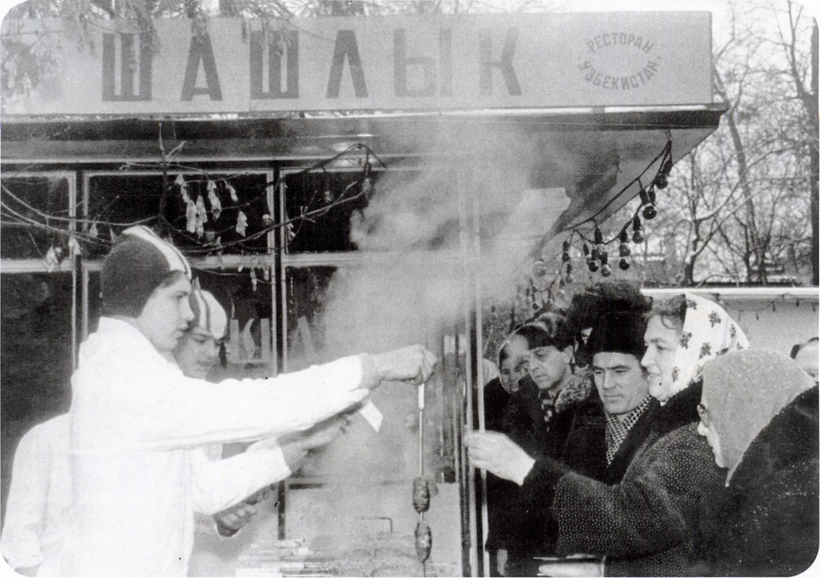
With the collapse of the USSR, however, Uzbekistan quickly became anachronistic, a neglected mastodon unable and unwilling to adapt. By the time I first visited the place in the mid-1990s, this had become a restaurant with tired decor and rude service, where a single copy of the printed menu was circulated around the room before the waitress told you that the dishes you ordered were either unavailable, or only available to a select few patrons that mattered more than you, or just too expensive for you. The food itself left no memory.
In 1997, restaurateur Arkady Novikov bought the restaurant with a couple of partners, and decided to give it new life via completely renovating the building. The banquet hall section of the old restaurant was quickly transformed into White Sun of the Desert (named after a cult film that epitomizes the little-known Red Western genre), an eatery favored by Russian businessmen, with competent waitstaff that didn’t insult you, and tasty food offered indiscriminately to all customers. Meanwhile, Uzbekistan’s main part was closed for a two-year renovation, though it might be more apt to call it a reconstruction, as it kept nothing of the original except the ceiling.
Incredibly, it took me almost twenty years to visit the place again (I had last dined at White Sun of the Desert in the summer of 1998). The new Uzbekistan has indeed reopened and resembles an Uzbek palace — Disneyland style. Novikov, still the owner, has become a powerhouse with over 60 restaurants in his portfolio (including some in London, Miami, and Dubai), serving more than 20 different types of cuisines.
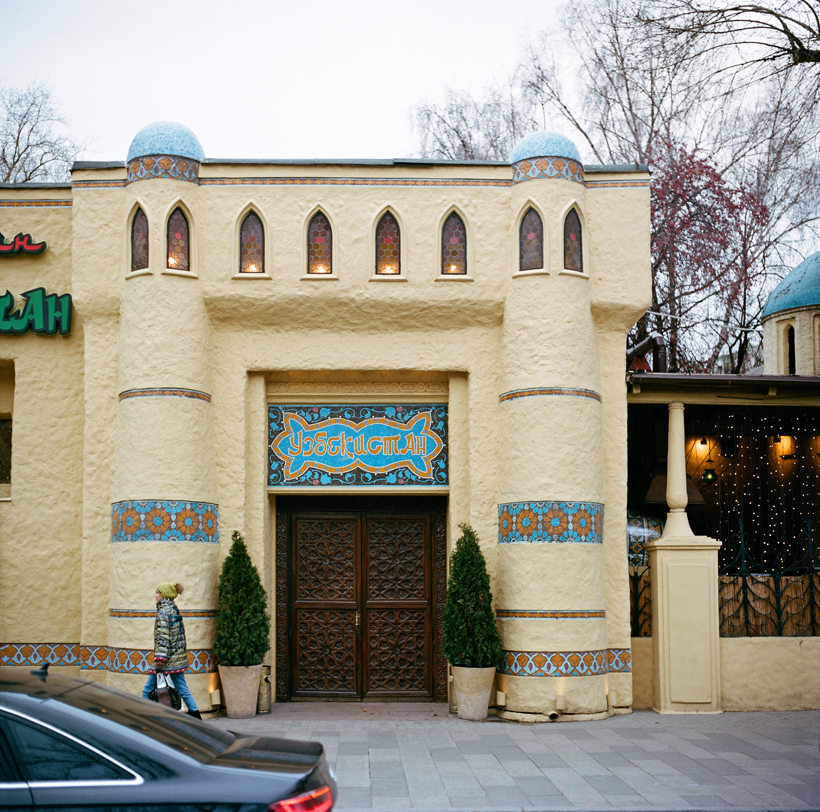
As with other New Russian ventures, especially the ones dating from the turn of the 21st century, it’s sometimes hard to decide if the decor is at all elegant or if it’s just kitsch. Supposedly contracted to skillful “oriental” craftsmen, taking inspiration from 200-year-old designs, and using handmade furniture and Uzbek chandeliers, the result evokes the Arabian Nights in the middle of a mish-mash built on the widespread Russian view that those people who live east of Moscow (be it the Caucasus, the Middle East, Central Asia, or any other part of Asia), they’re all the same — “oriental.”
Accordingly, Uzbekistan restaurant now serves a gigantic menu of “oriental” cuisines, divided into Uzbek, Arab, Pan-Asian (read: Chinese), and Transcaucasian (mostly Azerbaijani; apparently the Christian part of the Caucasus isn’t oriental enough), plus a section for seasonal specials. Next door, White Sun of the Desert still exists, sharing the same chef and the same menu, but with different decor, also flirting with kitsch but simpler and inspired by the eponymous movie, and with outdoor seating.
When I recently visited Uzbekistan for lunch on a weekday, the place started out quite empty, but progressively filled to a respectable level of occupancy (we’ll discuss the attendance problem of Moscow restaurants another time). The decor was augmented by holiday-themed decorations (garlands, colored lights, fake flames) that irrevocably tipped the scale towards the kitsch end, backed up by really bad technoid pop music playing out of the speakers. I hear that there’s also a belly dancer in the evening. Good times.
This, however, should not lead you to think that the food is mediocre. The restaurant insists on making everything in house, as per tradition: the noodles are handmade, the bread is baked in a tandoor oven, the kebabs are cooked on an open fire, the lamb is roasted on a spit, and making plov is an art (I’m quoting the marketing spiel here). The chef, Evgeny Dyomin, is a Moscovite who’s worked at prominent restaurants throughout the capital and beyond for the past 20 years, becoming intimately familiar with “oriental” cuisine before taking the reins at Uzbekistan in 2013.
Time to eat! The Uzbek section of the menu offers a generous selection of salads and soups (10 different soups!), followed by the usual darlings of Uzbek cuisine as mains, including plov, manty, lagman, samsa, and some original kebabs, from marbled beef to testicles (prudishly described as “light bulbs” — a delicacy about which you should ask your waiter). The desserts include a selection of homemade Dastarkhan sweets: baklava, gozinaki, mazurka (a cake with nuts and dried fruits), bird’s milk cake, and a few other layered cakes.
To start, the roulade Uzbekistan is a cold cut of lamb roulade, stuffed with a walnut, garlic, and clove mixture. The meat is tender and very good, not lean or dry like so many cooked red meats served cold. It goes well with a lepyoshka (aka Uzbek non). The latter is fresh and airy, though not the best I’ve ever eaten (it lacks salt).
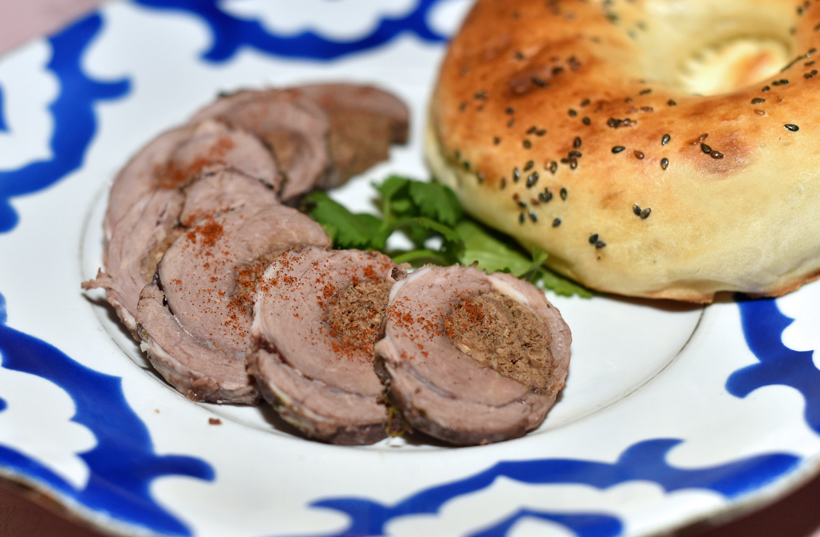
The mashkhurda is a hearty soup with mung beans, rice, small pieces of meat, and a lot of vegetables (carrot, onion, potato, tomato, parsley), served with cream and mint on the side. Very much in the tradition of Uzbek soups, it boasts a great vegetable flavor and contains at least as much solid as liquid.
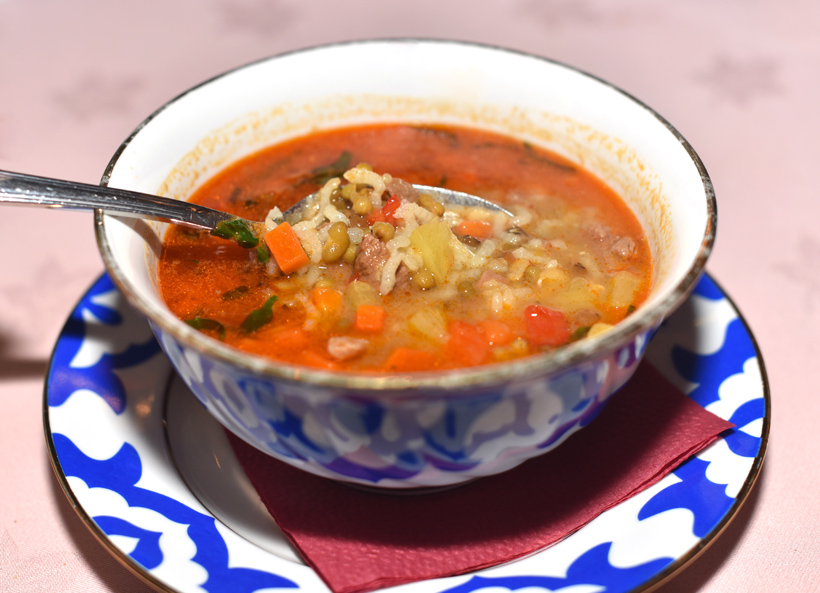
The shashlyk of black lamb tongues in oriental marinade is truly excellent. The perfectly cooked lamb tongues might be the best I’ve ever eaten; extremely tender and almost pink inside. I assume that the white stuff around them is the famous oriental marinade, probably a yogurt (or ayran) mixture, which coated the meat generously. We get a few tried and true pairings as garnishes: a slightly contrived arrangement of fire-roasted cherry tomatoes on zucchini slices, thinly sliced onions tossed with dill, and whole parsley sprigs for your health.
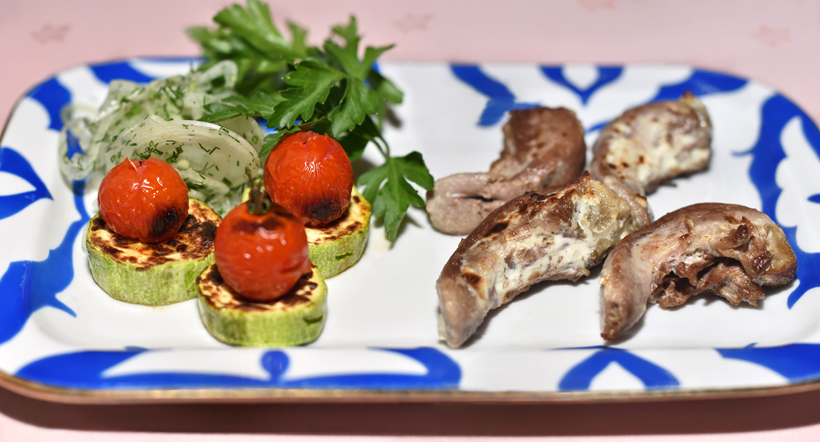
Uzbekistan serves two kinds of plov: a “regular” one (no details provided on the menu), and the “Uzbek plov by Novikov” (“Lazer rice, lamb meat and yellow carrot”). If you order the latter, the sous-chef comes to your table in person and serves the plov from a mangal in front of you, ready to spin a yarn about the Art of Plov if you so desire. And it’s a very good plov, quite authentic indeed, fragrant with wild cumin, perfectly cooked with tender carrots and tender chunks of lamb, which isn’t always easy. There’s the right amount of fat too; enough to please, but without a puddle of grease. The Lazer rice clearly deserves its reputation as one of the varieties of choice for plov: its absorptive properties allow it to pack in a lot of flavor, while its fairly long shape gives a distinctive appearance to the dish.
There are no barberries or chickpeas, just carrots and garlic (and, I assume, onions that completely melted during the cooking), so it’s rather minimalist compared to my own recent recipe. The fact checkers among us will notice a slight discrepancy with the menu, too: the carrots are obviously not yellow.
The plov comes with a kind of with achik-chuchuk, sliced ripe tomatoes tossed with thin onion slices, next to a julienne of cucumbers, all served on the same plate. I think this was actually the first time I saw the salad and the plov served together like this — restaurants are generally happier to charge you for both separately. On one hand it looks a bit like a plate from a rushed lunch formula, but on the other, it’s kind of interesting to switch back and forth between the rich rice dish and the refreshing salad.
I could go back to Uzbekistan restaurant with friends a dozen times, and I still wouldn’t be able to taste more than a fraction of their menu. But that’s besides the point. The important question to me is this: Is the place still worth visiting? After all, this is no longer the only Uzbek restaurant in Moscow. Far from it. Hell, if you live in central Moscow and want a cook from Tashkent, you just hire one. I’m clearly not fond of the decor (though I guess the outdoor seating at White Sun of the Desert next door must be more enjoyable in that regard, weather permitting, if only because one expects kitsch in a place named after a cult Red Western). The food ranges from good to really excellent, and all things considered, it isn’t overly expensive. Even if Uzbekistan isn’t the sensation it once was, I wouldn’t dismiss it either. Just close your eyes and imagine you’re dining in Stalin’s Moscow, ca 1951. Or not.

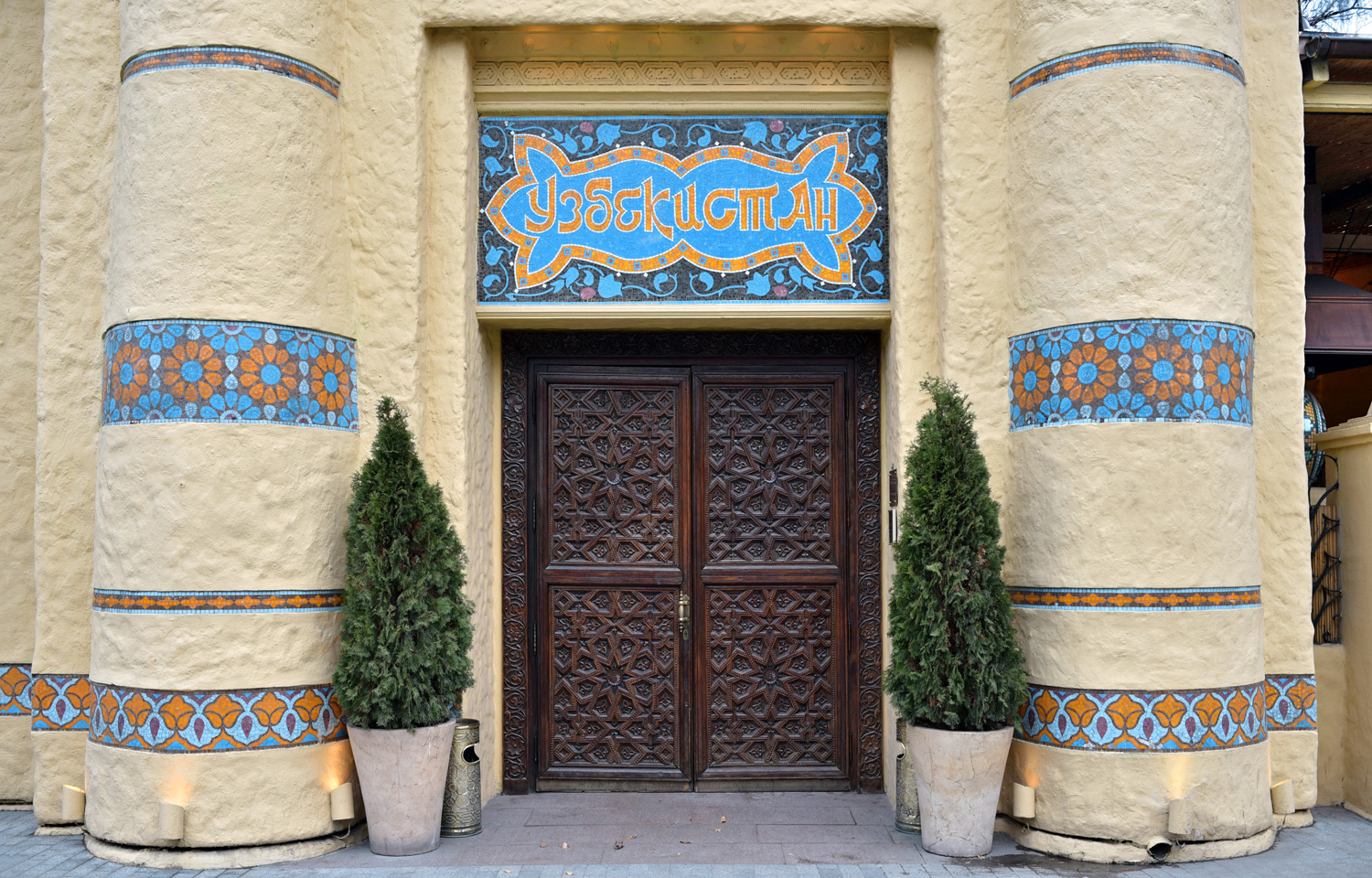










3 comments
Nice! I have eaten both in Uzbekistan and in an Uzbek restaurant in Moscow, so your article fills me with nostalgia. I am a British Hungarian (educated in England, living in France) and have enjoyed many of your articles, particularly those relating to the Caucasus. What a pity there no longer seem to be any good Georgian or Armenian restaurants in Paris. However, I do go to a little Armenian resto in Bergerac, sometimes. Keep me posted!
Florian- I love and savour your posts. Thank you so much for sharing the world of food and culture. I have learned so much and look forward to future travels through your posts.
Very informative article! Thank you for sharing. I’m from Uzbekistan, but I live in Australia. The plov you are not of course, the best version of authentic plov, you must try it in Uzbekistan to get the real taste of Uzbek Pulav. I’m sure Russian cook definitely lacks that trick.